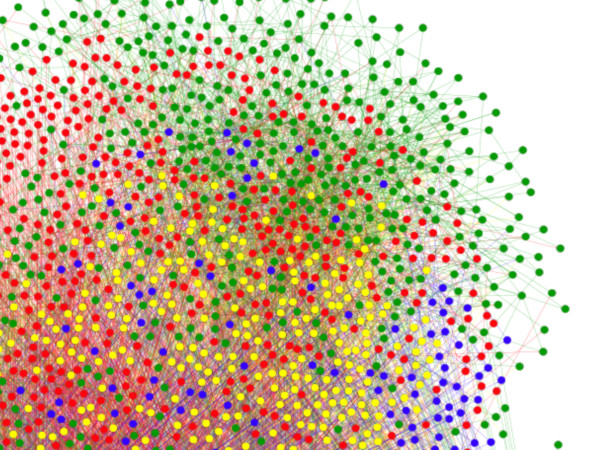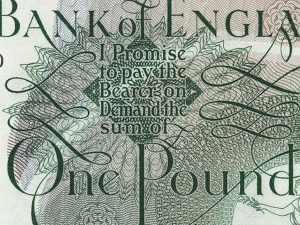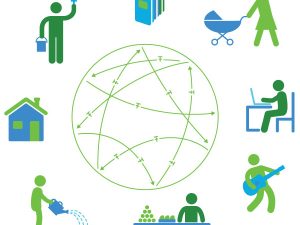Credit clearing - introduction

“If you want to continue to be slaves of the banks and pay the cost of your own slavery, then let bankers continue to create money and control credit” – Sir Joshiah Stamp
Contents
What is credit clearing?
Here’s a simple example. A owes B £10; B owes C £10; and C owes A £10. None of them has to obtain £10 to pay their debt. They can just cancel out, or ‘clear’ it. But it needs some sharing of information. In this case, A will only know that they owe B £10 and that C owes them £10. They’d all need to share information to discover that there’s a debt loop that can be cleared.



If the group was bigger than three people, and everyone owed different amounts, it becomes more complicated – but if information is shared, a lot of debt can still be cleared. When a loop is found, the smallest amount can be removed from each debt. So using the example above, if A owes B £5, B owes C £10 and C owes A £20, the smallest amount (£5) can be cleared from each debt, so that A now owes B nothing at all, B owes C £5 and C owes A £15. A total of £15 worth of debt has been removed without anyone paying anything.
After clearing, they can then settle their remaining accounts with each other (bring them back to zero by paying the remaining debts). Some definitions of clearing include this settlement too. The glossary of the Bank for International Settlements defines clearing as “the establishment of final positions for settlement” (so their definition doesn’t include settlement).
A network of trading businesses can use this method to cancel out/clear a lot of their obligations with each other, rather than making a payment for every single trade. The more debts that can be cleared, the less money is needed in the network and the less cashflow is a concern for everyone. Banks do it between themselves, instead of sending every single payment between different banks. So, if it’s good enough for them, it’s good enough for the rest of us!

In fact, the multilateral set-off, central clearing and mutual credit analogues described below are called ‘liquidity-saving mechanisms’ in the financial world – i.e. they don’t require money (or banks, debt, interest etc.), and so – to the extent they can be used – the quantity of circulating money just doesn’t matter. That has enormous implications – no need to compete for scarce money.
Types of clearing
Multilateral set-off
We were amazed to discover that the Slovenian government has helped its small businesses clear their debts for many years. Businesses send copies of their invoices to the govt. which uses an algorithm to find loops and clear debt. This is an example of a multilateral set-off scheme. You don’t have to change your trading partners or join an exclusive club, and you don’t have to extend trust to anyone outside your immediate trading network (and of course the service provider). It’s easy to set up and can achieve very large scale – in the case of Slovenia, national scale.

Central clearing
This is what happens if a group of friends go on holiday together, and at the end they compare how much they’ve spent and decide together how much each person puts into the shared pot, or how much they receive from it. The result is to minimise the amount of money and the number of payments needed for everyone to pay their fair share.
Within a multilateral set-off network, the algorithm might find small clusters of businesses that trade with each other regularly, that could have a shared ledger (record of transactions), with more trust, for central clearing: a ‘trade credit club’ if you like. At the end of the month or agreed time period, if a member’s account is in debit, they’ll make a payment (or if they’re in credit, receive a payment) to bring their account back to zero relative to the rest of the group. There needs to be greater trust between the members, which means that central clearing doesn’t scale in the same way that multilateral set-off does.
We would expect that a group might form from a cluster of around 10-20 businesses in a larger clearing network. A group of trading businesses could also set up a trade credit club, without first being in a multilateral set-off scheme.

Mutual credit
If a trade credit club decided not to bring accounts back to zero at certain time periods, but gave members credit and debt limits – this would be a de facto mutual credit club, where members trade with each other without the need for money or banks. In other words, credit clearing can be a ‘gateway drug’ for mutual credit. The use of money is completely avoidable only when members are able to consume from and supply to the network in equal quantities, leaving no debt to settle.
History
Money has only relatively recently permeated into most people’s lives. For merchants (for whom it would have been dangerous to travel with gold or silver coins) there was formal clearing at medieval trade fairs, and currency wouldn’t have seeped down to the community level for many ordinary people, who would use informal clearing (in their heads) with other locals.
Here’s a conversation with specialist Hans-Florian Hoyer about the history of credit clearing – especially at medieval trade fairs.

At the UN Bretton Woods conference in 1944, John Maynard Keynes – the world’s most respected economist at the time – suggested an International Clearing Union – in effect, a giant trade credit club with each country having an account – designed to balance international trade.
Keynes’ proposal was actually much fairer and some have argued would have led to a more peaceful world because it would have smoothed out all trade imbalances over time. But the US used its political muscle to implement a system that would support its long term interests. Henceforth countries would use US dollars to settle trade, which meant that everyone was borrowing from US banks or supplying the US with goods in order to obtain those dollars. Interest meant that net deficit countries fell ever deeper into debt to net surplus countries, exacerbating international tensions.
Even after the Marshall Plan had injected massive dollar liquidity into Europe, recovery was slow. The bilateral trade agreements that European countries had started signing after WW2 often had clauses that prevented deals with other countries, causing trading gridlock. So countries agreed to set up central clearing – a huge ‘trade credit club’, in fact, called the European Payments Union. Balance surpluses at the end of agreed time periods were paid off in gold. It turbo-charged the European economy because this simple multilateral agreement superseded the ‘spaghetti’ of bilateral agreements, and trade was much less limited by the dollars available for international payments.
What are the benefits of credit clearing?
Small businesses and communities
It reduces the amount of money (and therefore overdrafts / loans) that small businesses need; it solves a lot of cashflow / late payment problems. Tomaž Fleischman’s research (with Paolo Dini and Guiseppe Littera of Sardex) suggests that multilateral set-off could reduce the need for cash for small business by up to 25%; but for businesses within clusters that can use mutual credit, that figure rises to 50%!

It means that the real economy can finance trade without relying on a predatory financial sector: an economy where we just account for exchange makes the amount of money circulating irrelevant. The more loops we can make, the less money we need.
It can help decouple the real economy, where people do useful things, from the finance sector. While the finance sector is hardly affected by problems in the real economy because it is routinely bailed out, the opposite is not true, and financial crises mean the decimation of small businesses. An economy based on clearing would change that. It would insulate local economies from wider financial downturns.

Implemented via appropriate, mutually-governed platforms, it provides useful tools for ordinary (non-techie) people in ordinary communities so that they can get what they need and save money without requiring altruism – the holy grail for the growth of a new economy.
Sustainability
A clearing system doesn’t rely on endless GDP growth. With the current liquidity-based money system (i.e. based on money rather than clearing), every time there’s a crisis, the only response, rather than change the system, is to attempt to stabilise it through expansion – to create more financial assets, by promising to turn more of the natural world and human society into money; in short, to financialise everything and create the conditions for a yet larger crisis. Bank-issued money is directed to companies that are best at doing that, whereas removing bank-issued debt-money from the economy means that fewer people need to engage in economic activity just to earn the money to pay interest on debts, which is itself a key driver of exponential growth.

System change
In The End of Finance, Amato and Fantacci explain how transformative an economy based on clearing could be. In our current paradigm (which they call the liquidity paradigm), if there’s not enough money in circulation (e.g. during a credit crunch), the economy grinds to a halt. This scarcity of money stimulates people to struggle to accumulate it, leading to the enormous concentrations of wealth that corrupt democracy. It also gives the banks and the state enormous power, as issuers of liquidity – they decide who gets funded and what gets done (i.e. if it’s not in the interests of the banks and the state, it doesn’t get money).
If, on the other hand, we had an economy based on doing useful things for each other in communities, with a method of accounting for who’s done what for whom, then we can clear obligations without requiring money, and pay off any imbalances either directly with goods and services, or with claims (such as use-credit obligations) on goods and services that are backed by productive capacity under close local control.
This transcends left and right. If we can provide practical credit clearing tools to benefit ordinary people, then divisive left and right labels are irrelevant.
What can I do?
Our partners Mutual Credit Services are working to help set up clearing networks in the UK and elsewhere. They’re developing a city-wide clearing scheme in Liverpool.
If you think this could work in your community / trading network, get in touch, and we’ll introduce you to the right people to help you get started. This could be a multilateral set-off clearing network that could cover your county and involve thousands of businesses; or a trade credit club for a cluster of small businesses / sole traders that trade with each other regularly – a local Rotary Club, Chamber of Commerce or FSB group, or just an informal network of traders.
If you’re interested, there’s some prep work you can do. A basic preliminary survey of local businesses would be useful. How much do they trade with each other? How many trades per month? What sectors are the businesses in? What sizes are they? Do they collaborate well? Are they willing to try new things? MCS are working towards developing off-the-shelf solutions, but they’re not there yet. There will need to be some co-design of schemes to suit local circumstances.

MCS can help build clearing clubs based on the Credit Commons Protocol, meaning that for the first time, clearing networks could be connected together into much bigger systems, providing many more opportunities to reduce the need for cash.
Join the Circular Trade Analytics group if you’re interested in discussing the theory behind these ideas in more depth; and/or put your specific questions below and we’ll get them answered for you.
In 2023 there will be a conference about these kinds of mechanisms and how to implement them. Contact us if you’re interested and we’ll keep you informed. We’ll add more info to the comments below when we know more.
Further resources
- Growing the Commons forum – post queries on all commons topics here; there are specialists lurking to answer them for you.
- Growing the Commons blog – subscribe to be informed of commons news.
Specialist(s)
Thanks to Tom Woodroof of Mutual Credit Services for information.
The specialist(s) below will respond to queries on this topic. Please comment in the box at the bottom of the page.

Tom Woodroof is in the core team at Mutual Credit Services and convenes the Circular Trade Analytics forum. He has a PhD in applied nuclear physics from the University of Liverpool.







1 Comment
I’m designing the conference “Collaborative Finance: Credit where Credit’s due”
It will be at https://www.crypto-commons.org/crypto-commons-hub on 22nd-28th May.
Prices including all meals from 350EUR.
Blurb…
During a decade of blockchain shilling and now DeFi, the central issue of how communities and networks can create and manage credit without subjecting themselves to corrupt institutions, seems to have fallen by the wayside. Movements like LETS and timebanking have settled into a niche and the local currencies (backed by fiat) have had no measurable impact and died out.
So what next?
There remain many ideas, especially those grounded in the credit theory of money, which have yet to be tried, or tried at scale. We’ll be exploring some of these in depth, and asking how diverse projects can support each other to manifest monetary networks at scale. We will focus on three core mechanisms:
– Multilateral Offset Clearing: identifying loops in payment networks to cancel out payments and ease cashflow. These networks offer concrete benefits to members and are easy to participate in.
– Mesh Credit (Ripple-like payments): establishing a mesh of ‘trustlines’ enables payments between strangers using credit which is all backed by one’s immediate associates.
– Mutual Credit / Credit Commons: commiting to balance trade within a network means that no money is needed at all, only accounting. These networks can be nested to keep them independent and meaningfully governable by their members.
Builders of such systems, both renowned and obscure, are invited for an informal week in the mountains to share their ideas and challenges, and to explore opportunities for collaboration at scale. Formal presentations will be limited and unstructured time will be abundant.